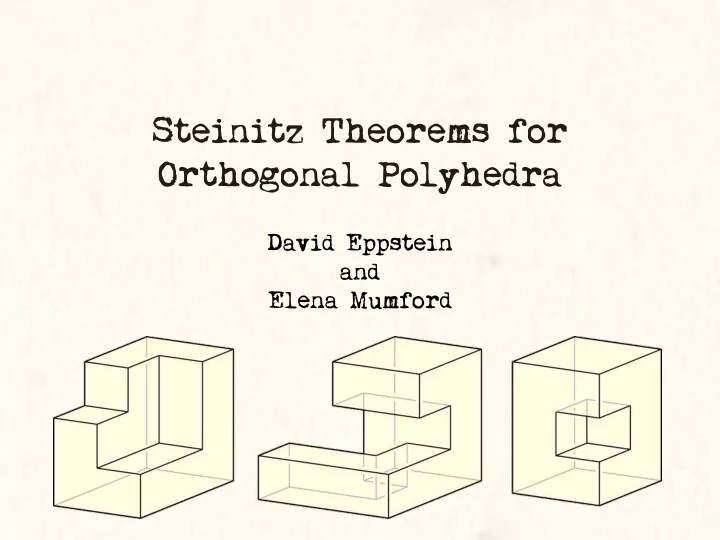

Steinitz Theorems for Orthogonal Polyhedra David Eppstein and Elena Mumford
Steinitz Theorem for Convex Polyhedra Steinitz: skeletons of convex planar = polyhedra in R 3 3-vertex-connected graphs
Simple Orthogonal Polyhedra Topology of a sphere • Simply connected faces • Three mutually perpendicular edges at every vertex simple orthogonal polyhedra
Simple Orthogonal Polyhedra Topology of a sphere • Simply connected faces • Three mutually perpendicular edges at every vertex Orthogonal polyhedra that are NOT simple
Corner polyhedra All but 3 faces are oriented towards vector (1,1,1) = Only three faces are “hidden”
Corner polyhedra Hexagonal grid drawings with two bends in total
XYZ polyhedra Any axis parallel line contains at most two vertices of the polyhedron
Skeletons of Simple Orthogonal Polyhedra are exactly Cubic bipartite planar 2-connected graphs such that the removal of any two vertices leaves at most 2 connected components
Skeletons of Simple Orthogonal Polyhedra a graph that is NOT a skeleton of a simple orthogonal polyhedron are exactly Cubic bipartite planar 2-connected graphs such that the removal of any two vertices leaves at most 2 connected components
Skeletons of XYZ polyhedra are exactly cubic bipartite planar 3-connected graphs
Skeletons of XYZ polyhedra are exactly cubic bipartite planar 3-connected graphs Eppstein GD‘08 A planar graph G is an xyz graph if and only if G is bipartite, cubic, and 3-connected.
Skeletons of Corner Polyhedra are exactly cubic bipartite planar 3-connected graphs s.t. every separating triangle of the planar dual graph has the same parity.
Skeletons of Corner Polyhedra are exactly cubic bipartite planar 3-connected graphs s.t. every separating triangle of the planar dual graph has the same parity.
Skeletons of Corner Polyhedra are exactly cubic bipartite planar 3-connected graphs s.t. every separating triangle of the planar dual graph has the same parity.
Skeletons of … … simple orthogonal polyhedra are cubic bipartite planar 2-connected graphs s.t. the removal of any two vertices leaves at most 2 connected components … XYZ polyhedra cubic bipartite planar 3-connected graphs … corner polyhedra cubic bipartite planar 3-connected graphs s.t. every separating triangle of the planar dual graph has the same parity.
Rough outline for a 3-connected graph 1. Split the dual along separating triangles 2. Construct polyhedra for 4-connected triangulations 3. Glue them together:
Rooted cycle covers 1. Collection of cycles 2. Every inner vertex is covered exactly once 3. Every white triangle contains exactly one edge of the cycle
Rooted cycle covers Rooted cycle cover = embedding as a corner polyhedron Every 4-connected Eulerian triangulation has a rooted cycle cover
Rough outline for a 3-connected graph 1. Split the dual along separating triangles 2. Construct polyhedra for 4-connected triangulations 3. Glue them together:
Results • Combinatorial characterizations of skeletons of simple orthogonal polyhedra, corner polyhedra and XYZ polyhedra. • Algorithms to test a cubic 2-connected graph for being such a skeleton in O(n) randomized expected time or in O(n (log log n) 2 /log log log n) deterministically with O(n) space. • Four simple rules to reduce 4-connected Eulerian triangulation to a simpler one while preserving 4-connectivity.
Questions?
Recommend
More recommend